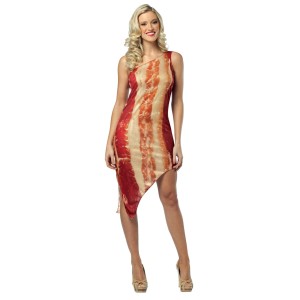Halloween has earned a nasty reputation for perpetuating oppression. Women are encouraged to wear “slutty” costumes that leave little to the imagination and also leave women to freeze in the late October weather (for Northern Hemisphere folk), generally for the enjoyment of men. Caricatures of Native Americans, disabled people, people of size, Mexicans, Chinese, Japanese, Indian, Arabs, etc. all become fair game for costumes. In other words, Halloween has become a celebration of white male Western dominance, and anyone who has a problem with that “can’t take a joke.”
Gender, class, ability, size, and race all intersect in the multitude of horrendous, problematic costumes, so we should not be surprised to find the same for species. There are countless costumes that degrade other animals. One of the most horrific is a strap-on sheep that is made to appear as though she is being raped by a stereotypical “hillbilly” (a derogatory caricature of Appalachian peoples).
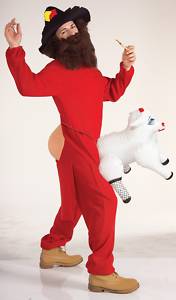 There are many variations of this costume for men. But, for women?
There are many variations of this costume for men. But, for women?
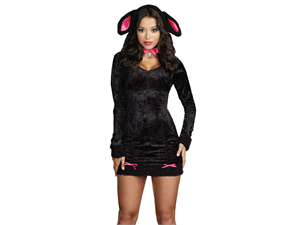 Notice how the male version, while horribly classist, still demonstrates male superiority over the feminine. The female version demonstrates female vulnerability/animal vulnerability. In both cases, the “sheep” is feminized and portrayed as a male sexual resource. See also American Apparel’s “zookeeper and animals” costumes.
Notice how the male version, while horribly classist, still demonstrates male superiority over the feminine. The female version demonstrates female vulnerability/animal vulnerability. In both cases, the “sheep” is feminized and portrayed as a male sexual resource. See also American Apparel’s “zookeeper and animals” costumes.
There are several costumes that also juxtapose femininity with animality, sexual availability, and the desire to be consumed. Check out sexy bacon, sexy pepperoni pizza, and sexy hamburger and hot dog:
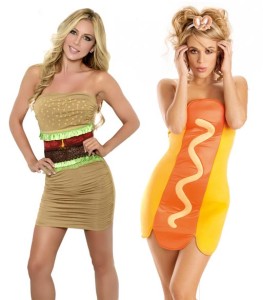 These are brilliant examples of Carol Adams’s sexual politics of meat theory: Women are animalized, animals are feminized, and living persons become dead objects. They become fragmented pieces of flesh for those in power to pleasurably consume. These pieces of meat are made sexy. They want you to eat them.
These are brilliant examples of Carol Adams’s sexual politics of meat theory: Women are animalized, animals are feminized, and living persons become dead objects. They become fragmented pieces of flesh for those in power to pleasurably consume. These pieces of meat are made sexy. They want you to eat them.
In researching this article, I actually came across several “sexy” women’s costumes that sexualized non-animal food items as well. While sexy hamburgers and hot dogs are especially problematic because they intersect sexism and speciesism, I’m not convinced that sexy corn-on-the-cob, sexy chewing gum, or sexy watermelon is much of an improvement.
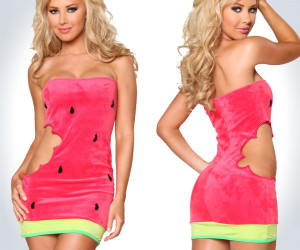 Sexualized food costumes for women reinforce the notion that women are resources to be consumed. They are non-persons, they are objects, they are here at your disposal. At least these costumes leave Nonhuman Animals out of it, but they’re still pretty darn problematic.
Sexualized food costumes for women reinforce the notion that women are resources to be consumed. They are non-persons, they are objects, they are here at your disposal. At least these costumes leave Nonhuman Animals out of it, but they’re still pretty darn problematic.
 Dr. Wrenn is Lecturer of Sociology. She received her Ph.D. in Sociology with Colorado State University in 2016. She received her M.S. in Sociology in 2008 and her B.A. in Political Science in 2005, both from Virginia Tech. She was awarded Exemplary Diversity Scholar, 2016 by the University of Michigan’s National Center for Institutional Diversity. She served as council member with the American Sociological Association’s Animals & Society section (2013-2016) and was elected Chair in 2018. She serves as Book Review Editor to Society & Animals and has contributed to the Human-Animal Studies Images and Cinema blogs for the Animals and Society Institute. She has been published in several peer-reviewed academic journals including the Journal of Gender Studies, Feminist Media Studies, Disability & Society, Food, Culture & Society, and Society & Animals. In July 2013, she founded the Vegan Feminist Network, an academic-activist project engaging intersectional social justice praxis. She is the author of A Rational Approach to Animal Rights: Extensions in Abolitionist Theory (Palgrave MacMillan 2016).
Dr. Wrenn is Lecturer of Sociology. She received her Ph.D. in Sociology with Colorado State University in 2016. She received her M.S. in Sociology in 2008 and her B.A. in Political Science in 2005, both from Virginia Tech. She was awarded Exemplary Diversity Scholar, 2016 by the University of Michigan’s National Center for Institutional Diversity. She served as council member with the American Sociological Association’s Animals & Society section (2013-2016) and was elected Chair in 2018. She serves as Book Review Editor to Society & Animals and has contributed to the Human-Animal Studies Images and Cinema blogs for the Animals and Society Institute. She has been published in several peer-reviewed academic journals including the Journal of Gender Studies, Feminist Media Studies, Disability & Society, Food, Culture & Society, and Society & Animals. In July 2013, she founded the Vegan Feminist Network, an academic-activist project engaging intersectional social justice praxis. She is the author of A Rational Approach to Animal Rights: Extensions in Abolitionist Theory (Palgrave MacMillan 2016).
Receive research updates straight to your inbox by subscribing to my newsletter.

